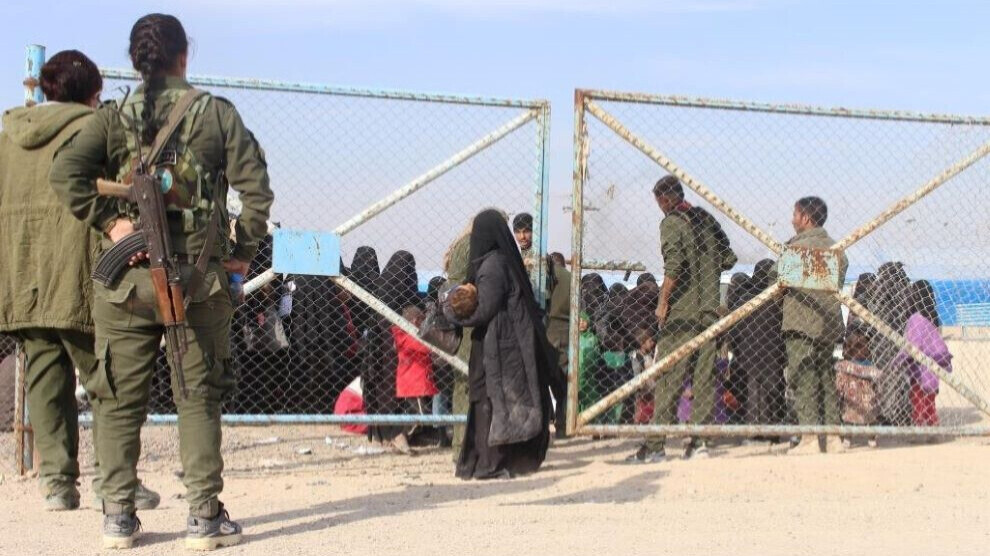Young Iraqi refugee killed in Hol Camp
In the Hol internment and refugee camp near Hesekê, an Iraqi refugee was shot dead by unknown persons.
In the Hol internment and refugee camp near Hesekê, an Iraqi refugee was shot dead by unknown persons.

According to the Rojava-based Hawar News Agency, a young refugee from Iraq was murdered in the notorious Hol Camp in northern Syria.
Reports from the ground say that 25-year-old Ahmet Mahmut Dahir was murdered by two masked persons with 5 gunshots at around 5 pm on December 12th.
Hol: Secret Capital of ISIS
The Hol Camp is massively overcrowded with more than 65,000 inmates. The camp not only accommodates refugees, but also interned jihadists. They live together with their children. The ISIS women have built up their own structures and commit atrocities against people who want to separate from the ISIS or who do not live according to the standards of the ISIS. It is not for nothing that the camp, which is in many areas hardly controllable, has the reputation of being the new capital of the ISIS. The situation there is related to the lack of international support for the Autonomous Administration of North and East Syria and the constant attacks by Turkey. The Turkish secret service MIT supports the jihadists in the camp and has helped some to escape.
General amnesty to remedy the situation
The Autonomous Administration tried to counteract this situation with a general amnesty for Syrian ISIS members who have not been accused of any serious crimes. About 25,000 inmates of Hol Camp can make use of this amnesty.
The camp is currently home to about 65,000 people from more than 50 different countries, including thousands of ISIS families who were captured by the Syrian Democratic Forces (SDF) after the capture of the last bastion of the Islamist terrorist organization in March last year near Hajin near Deir ez-Zor, and is considered one of the most dangerous camps in the world.
The tent city was erected by the UNHCR for Iraqi refugees in early 1991 during the Second Gulf War. After the camp was closed for a while, it was reopened in 2003 in the course of the Iraq war. For the past year and a half, it has been used mainly to house women and children who previously lived in areas under ISIS control. A major problem, however, is the massive overcrowding. The conditions are catastrophic due to the lack of aid from the international community, and medical care is miserable.
Most of the Syrians interned in Hol Camp are members of ISIS jihadists, but there are also many internally displaced persons. The 30,000 Iraqi women, including 20,000 children, and nearly 10,000 foreigners, including 7,000 children, are staying in the camp for the time being. The central government in Baghdad virtually halted the repatriation of Iraqi citizens a while ago, and there is no response to requests from northeast Syria.
Murder and stabbing crimes have remarkably increased in the Hol Camp recently. Women are behind most of these crimes in an effort to preserve extremist ideology among their families, and spread it among Iraqi refugees.
In a recent report documenting continuing violations and abuses by nearly every conflict actor controlling territory in Syria, the Independent International Commission of Inquiry on the Syrian Arab Republic accused the SDF of the long detention or internment of ISIS jihadists and their relatives in prisons and camps under their control, including the Hol Camp.
SDF Commander General Mazlum Abdi criticized the report, saying that the "complex and international dimension" of the situation in the Hol Camp was "unjustifiably" ignored. The camp is home to some 65,000 people from dozens of different countries, including thousands of ISIS members and their families who were apprehended by the SDF after the capture of the terrorist organization's last bastion in eastern Syria last March. "Most states refuse to take back their nationals held in the camp. International organizations have reduced their role to humanitarian aid," said Mazlum Abdi.